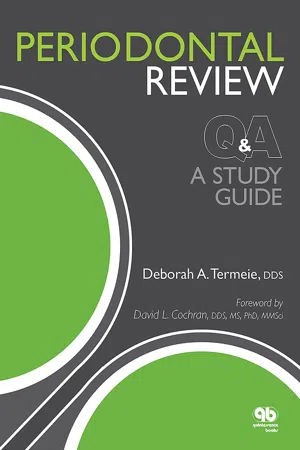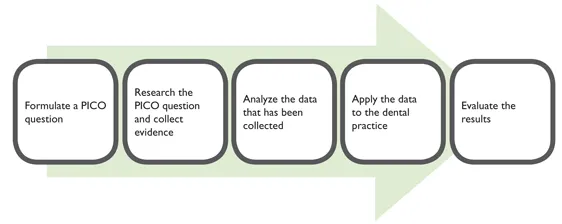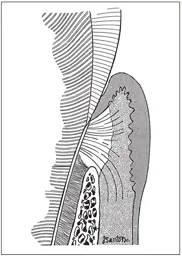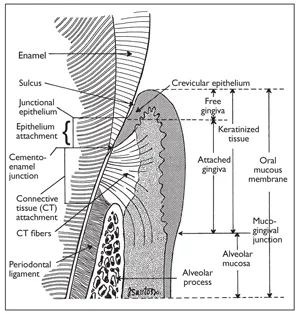![]()
Evidence-Based Dentistry
Background
Q: What is the evidence-based approach?
Evidence-based dentistry is the merging of clinically pertinent scientific evidence to the patient’s oral and medical condition and history. The dentist uses the evidence to make sound decisions about diagnosis, prognosis, and treatment.
Q: What is the PICO question?
The PICO question is a question that includes a population to be examined, the nature of the intervention to be inspected, a comparison statement, and the type of outcome to be evaluated. It should be problem-focused and concise.
Example: In patients with periodontitis (population), what is the effect of osseous surgery (intervention) compared with controls (comparison) on clinical and patient-centered outcomes (outcome)?
Q: What is the step-by-step process for making an evidence-based decision in a dental practice?
The steps involved in evidence-based decision making in a dental practice are shown in Fig 1-1.
Fig 1-1 Evidence-based decision making. (Based on data in Chiappelli et al.1)
Studies
Q: What are the different study types (ranked from highest level of evidence to lowest)?
The different types of studies are shown, ranked in order of highest to lowest level of evidence, in Fig 1-2.
Fig 1-2 Different studies ranked from highest level of evidence to lowest. (Based on Chiappelli et al.2)
Q: Describe the difference between a cross-sectional study and a longitudinal study.
A cross-sectional study is done at one time point, whereas a longitudinal study ranges over a period of time, allowing temporal relationships to be investigated.
Q: What is the P value?
The P value is the probability of obtaining a test statistic at least as extreme as the one observed, assuming that the null hypothesis is true. The smaller the P value, the less likely the effect was due to chance.
Q: What is the difference between internal and external validity?
The difference between internal and external validity is shown in Fig 1-3.
Fig 1-3 Internal and external validity.
References
1. Chiappelli F, Brant XMC, Oluwadara OO, Neagos N, Ramchandani MH. Introduction: Research synthesis in evidence-based clinical decision-making. In: Chiappelli F, Brant XMC, Neagos N, Oluwadara OO, Ramchandani MH (eds). Evidence-Based Practice: Toward Optimizing Clinical Outcomes. London: Springer, 2010:5.
2. Nocini PF, Verlato G, De Santis D, et al. Strengths and limitations of the evidence-based movement aimed to improve clinical outcomes in dentistry and oral surgery. In: Chiappelli F, Brant XMC, Neagos N, Oluwadara OO, Ramchandani MH (eds). Evidence-Based Practice: Toward Optimizing Clinical Outcomes. London: Springer, 2010:151.
![]()
Periodontal Anatomy
Anatomy
Q: Identify the anatomical structures of the periodontium shown below.
Fig 2-1a Illustration of the periodontium. (Reprinted from Fan and Berry1 with permission.)
The answers are shown on the next page in Fig 2-1b.
Fig 2-1b Labeled anatomy of the periodontium. (Reprinted from Fan and Berry1 with permission.)
Q: Where does the vascular supply of the periodontium originate?
The external carotid artery and its main branches, which include the lingual, facial, and maxillary arteries, are the vascular supply for the periodontium. Locally, the blood supply comes from the supraperiosteal vessels and vessels from the periodontal ligament (PDL) and bone.2
Q: What is the main innervation for the periodontium?
The trigeminal nerve and its branches provide the main innervation for the periodontium.
Definitions
Q: What is attached gingiva?
The attached gingiva is the area from th...







